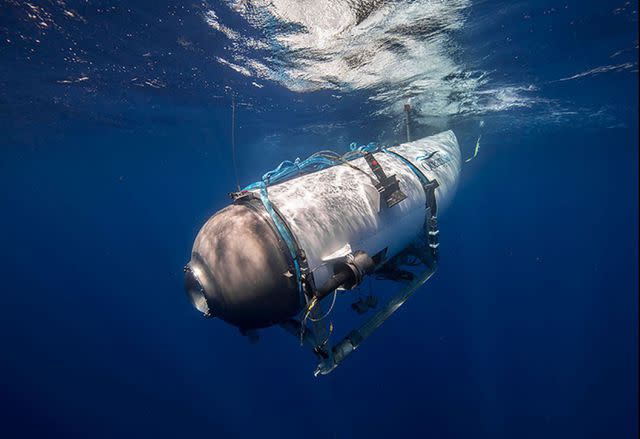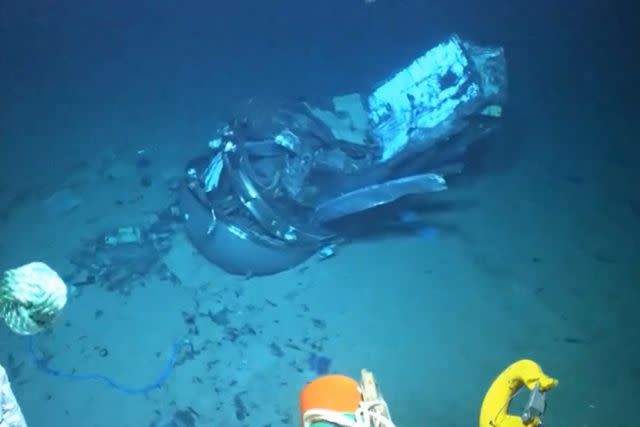“All it takes is that one thing to go for the whole thing to go,” engineer Bart Kemper told investigators

Petty Officer 2nd Class Kate Kilroy/U.S. Coast Guard via AP, Pool
Bart Kemper of Kemper Engineering testifies on Sept. 25, 2024, at the U.S. Coast Guard Marine Board of Investigation hearing into the June 2023 loss of the Titan submersible
An engineer whose firm was asked by the U.S. Coast Guard to offer additional expertise in the investigation of the deadly 2023 Titan submersible implosion testified this week that the “root cause” of the disaster is unknown at the moment — but there are some plausible options.
Debris from the Titan was found near the wreck of the Titanic in June 2023, four days after the submersible lost contact with the surface while en route to the famed shipwreck, officials have said.
The five people aboard all died.
Bart Kemper, of the firm Kemper Engineering, was among the witnesses at the ongoing Coast Guard Marine Board of Investigation hearing into the Titan tragedy and the decisions made by OceanGate, the company behind the sub.
“The root cause for the implosion is indeterminate at this time,” Kemper told the panel on Wednesday, Sept. 25, during a presentation of his company’s summary of preliminary findings.
“There are multiple unmitigated single-mode failures, which means that all it takes is that one thing to go for the whole thing to go,” he said.
The sub was deep underwater when it lost contact, and was under extreme pressure, which experts have said means any failure of its structural integrity would have led to an instantaneous — fatal — implosion of its pressurized passenger compartment.


HANDOUT/OceanGate Expeditions/AFP via Getty
The Titan
Kemper identified five possible causes that initiated the implosion, all related to the sub’s makeup.
These include an “internal localized failure” due to “cumulative carbon fiber breakage,” a failure of the “composite hull due to fabrication” — also known as a failure in manufacturing — or a failure from exposure damage, failure of the glue ring that connected the sub’s hull and ring or a failure of its acrylic window, which was the only way to look out from within.
Other witnesses have offered their insights into what they think caused the submersible’s deadly implosion.
In separate testimony at the hearing, last week, Tym Caterson, a former OceanGate contractor, said he believes the failure “happened at the forward glue line at the ring,” which would have had to “happen extraordinarily fast.”
“Which means the people in there, they had no idea this was coming. I just want to make sure you let the public know nobody was suffering in there,” said Caterson, who was present when the Titan began its final dive from the Polar Prince off the coast of Canada on June 18, 2023.
Don Kramer, a National Transportation Safety Board (NTSB) engineer, testified on Wednesday that the pieces from the sub’s wreckage showed separation “within the hull’s adhesive, primarily through the carbon fiber composite.”
Kemper said during his testimony that in December 2017, his firm was asked by Wiliam Kohnen — whose company Hydrospace Group constructed the window used on the Titan — to do a “pro bono analysis of a non standard acrylic window for [another OceanGate sub] Cyclops II.”
About a month later, January 2018, Kemper’s firm furnished a report to Ocean Gate that the “results indicated failure likely after multiple full-depth dives,” based on that window’s design.
“The results indicated it was possible the window would fail in cyclic failure,” read Kemper’s presentation at the Coast Guard hearing about his firm’s 2018 report. “We did not have the head design to analyze the mechanical response of the pressure boundary to the dive profile. The intent was to start a discussion to agree upon a safer, more reliable solution.”


HANDOUT/US Coast Guard / Pelagic Research Services/AFP via Getty
Debris from the Titan after its implosion
During questioning for Kemper, the Coast Guard panel referenced a previous loud banging noise linked to the Titan.
One of the panelists asked Kemper if he would have allowed the sub to continue diving if it experienced such noise upon surfacing.
“No,” Kemper replied. “I would’ve done more investigative work and considered my options of what’s available for testing, what’s not available for testing.”
In testimony on Tuesday, Sep. 24, Karl Stanley, a friend of OcenaGate co-founder and CEO Stockton Rush, who piloted the Titan on its final dive last year, recalled hearing concerning noises during a 2019 submersible dive he took with Rush and two others while in the Bahamas.
Related: How the Titan Broke Apart (and What Was Left) After Deadly Implosion, According to New Photos
“He told us to be prepared for noises,” Stanley said of Rush at the time. “He had recently done [a] solo dive on his own, and basically just said, ‘This is going to make noise,’ and, ‘Brace yourselves.’ ”
Looking back, Stanley said that there were a lot of “red flags” during that dive, including the noise, which he believed was the carbon fiber hull snapping.
“We were hearing it so often,” he told the investigators on the panel, noting that even though Rush had warned them, “The first couple of times [were unnerving].”
The panel also asked Kemper if a submersible that carries people — even an experimental one — should be designed if the life cycle of the system is uncertain.
“It’s flat wrong,” Kemper responded. “When you look at any sort of design, the first thing is you set your requirements. If you don’t have requirements, how do you know you’re good?”
He later added: “The only way that’s acceptable as a concept is if it’s something you can break [like a] toy. Toys are built that way. If they break, you just hurt feelings.”


Petty Officer 2nd Class Kate Kilroy/U.S. Coast Guard via AP, Pool
Bart Kemper
“If you are doing something that’s life safety … there’s no coming back from that,” Kemper said. “You don’t get a second chance. You get to say ‘oops’ once.”
Toward the end of his testimony, Kemper offered some recommendations to the panel so that a future tragedy like the Titan’s could be prevented — which is expected to be a key area of the Coast Guard’s work in investigating the implosion.
Those suggestions included a requirement that an experimental craft carry just two people — “an operator and assistant, with no passengers or cargo”; and to have a licensed professional engineer as a part of the engineering team.
The nearly two-weeks hearing by the Coast Guard investigative board — which is set to conclude on Friday, Sept. 27 — have featured testimonies from former OceanGate employees, experts and others about their experiences at the company and on the Titan’s previous dives.
In his final remarks on Tuesday, Stanley, who also runs a dive expedition company, said: “OceanGate came very, very close to killing me and had a severe impact on my business as well as an entire industry.”
Stanley also said that he believed his late friend Rush was looking to make a mark on history. “I think these wealthy individuals … threw money at him,” he said. “And he was painted into a corner … I think that’s why he kept diving.”
Per a previous statement obtained by PEOPLE, OceanGate, which has suspended all operations, said it has been “fully cooperating with the Coast Guard and NTSB [National Transportation Safety Board] investigations since they began.”
“OceanGate expresses our deepest condolences to the families and loved ones of those who died in the tragic implosion of the Titan,” the company’s statement continued. “There are no words to ease the loss endured by the families impacted by this devastating incident, but we hope that this hearing will help shed light on the cause of the tragedy.”
For more People news, make sure to sign up for our newsletter!
Read the original article on People.
